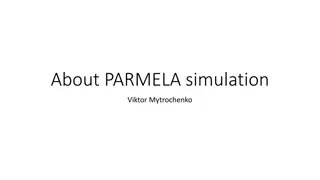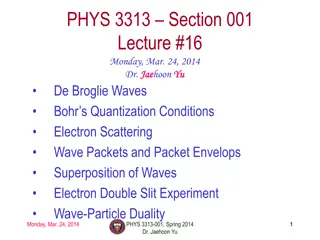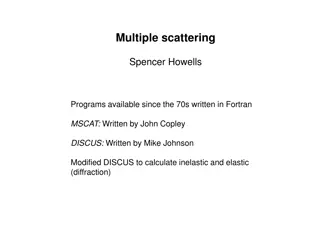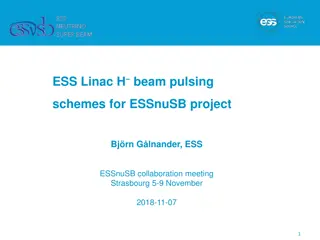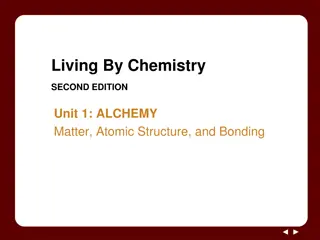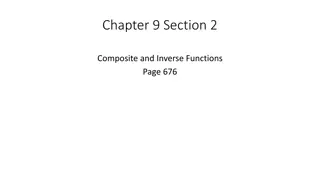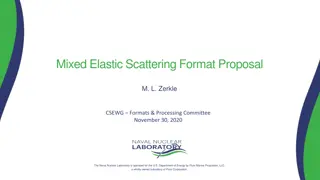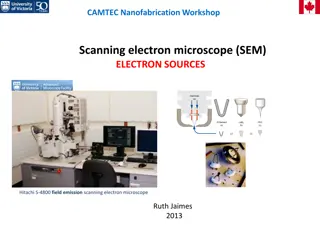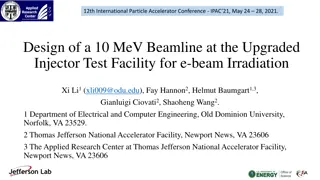Electron Beam Analysis and Optimization for RF Linac in Inverse Compton Scattering
This research activity report discusses the analysis and optimization of a 6D phase space electron beam for RF Linac-based Inverse Compton Scattering radiation sources. It covers the SPARC_LAB Thomson Source and ELI-NP GBS, including experiments, simulations, and studies on beam parameters and structures. The report delves into the peculiarities and specifications of the SPARC_LAB Thomson source, beam interactions, and simulations performed. The focus lies on high brightness photoinjectors, laser systems, energy tunability, and applications in various fields such as medical imaging and cultural heritage.
Uploaded on Sep 28, 2024 | 0 Views
Download Presentation

Please find below an Image/Link to download the presentation.
The content on the website is provided AS IS for your information and personal use only. It may not be sold, licensed, or shared on other websites without obtaining consent from the author. Download presentation by click this link. If you encounter any issues during the download, it is possible that the publisher has removed the file from their server.
E N D
Presentation Transcript
17/10/2016 Reserch Activity Report 6D Phase Space Electron Beam Analysis And Optimization For Rf Linac Based Inverse Compton Scattering Radiation Sources Anna Giribono PhD Student in Accelerator Physics La Sapienza University of Rome Supervisors: Prof. Luigi Palumbo Doct. Cristina Vaccarezza on behalf of the SPARC_LAB and ELI-NP team
Outline 6D phase space electron beam analysis and optimization for RF linac based Inverse Compton Scattering Radiation Sources 1. SPARC_LAB Thomson Source ( 20 500 keV ) 2. ELI-NP GBS ( 0.2 19.5 MeV ) SPARC_LAB Thomson Source SPARC_LAB experiments First and second commissioning phase ELI-NP GBS Start to end simulations Linac error sensitivity studies Quasi-constant gradient C-band structures Longitudinal long-range wake field effects in multi bunch operation
Inverse Compton Scattering Radiation Sources High Brigthness Photoinjector + Intense High Power Laser System SPARC_LAB Thomson Source ELI-NP GBS
The SPARC_LAB Thomson source Peculiarities of the source are: 1. Energy tunability of the source in the range [20 500] keV 2. Moderate mono-chromaticity of the source with a BW (rms) 10% 3. Useful for medical imaging, cultural heritage, etc.. Beams Parameters @IP Electron Beam Q = 100 - 800 pC Energy Energy spread Bunch length nx,y Focal Spot Size Laser Beam = 800 nm Energy Focal Spot Size 30 - 150 < 0.1 15 - 20 1 3 5 - 20 MeV % ps SPARC_LAB - Beam Specifications Energy Flux within FWHM BW BW (rms) Source Size 20 500 109 10 10 keV Nph/pulse % m mm mrad m 0.2 - 2 10 J m
The SPARC_LAB Thomson source Interaction Point e- bea m Optical transfer line Double Dogleg Cathode Laser Room 50 mJ Ti:Sapphire laser RF GUN 5 MeV 1.6 cell S-band LINAC composed of 3 50MeV TW S-Band structures
The SPARC_LAB Thomson source Simulations of the beam envelope up to the IP have been performed with the TSTEP/TRACE 3D code (Elegant) Space charge contribution At IP x,y 50 m Correction of the horizontal dispersion in the double dogleg TRACE 3D simulation of Twiss parameters along the LINAC Measured parameters Committed electron beams at 50 MeV (2014) and 30 MeV (2015) with 104 photons/shot Spot size focusing limited by the background noise on radiation diagnostic system. 50MeV Beams Parameters @IP Energy Energy spread Bunch length nx,y Focal Spot Size 50.6 0.2 30 0.2 0.1 3.1 0.2 2.2 0.1 2.2 90 3 MeV % ps 0.06 4.0 110 9 mm mrad m
The ELI-NP -source Peculiarities of the -source are: 1. Energy tunability of the -source in the range [0.2 20.0] MeV 2. Mono-chromaticity of the -source with a BW (rms) 0.5% 3. Peak brilliance of the -source > 1021 [Nph/s mm2 mrad2 0.1%] 4. Useful for nuclear physics and a wide range of applications 75 MeV Energy Tunability of Electron Beam 740 MeV 0.04% Energy Spread of ElectronBeam (%) 0.1% 0.2 mm mrad n 0.6 mm mrad 15 m t 30 m
The ELI-NP -source Beams Parameters @IP Electron Beam Q = 25 - 400 pC Energy Energy spread Bunch length nx,y Focal Spot Size Laser Beam = 515 nm Energy Focal Spot Size GBS - Beam Specifications Energy Flux within FWHM BW 75 740 0.04 - 0.1 100 - 400 0.2 0.6 > 15 MeV % m 0.2 20.0 MeV 2.6 105 Nph/pulse mm mrad m Nph/s mm2 mrad2 0.1% % m Peak brilliance 1020 - 1023 BW (rms) Source Size 0.5 10 - 30 0.2 0.4 > 28 J m
Machine layout HYBRID SCHEME CONSISTING IN A SPARC-LIKE S-BAND HIGH BRIGHTNESS PHOTOINJECTOR FOLLOWED BY A C-BAND RF LINAC C-BAND RF LINAC Higher accelerating gradients provided by the C-band accelerating sections in the rest of the linac allow to compact its length. S-BAND HIGH BRIGHTNESS PHOTOINJECTOR In the RF gun a bunch long enough, z 1mm, is needed to reduce the emittance degradation in the space charge dominated regime. LINAC 1 LINAC INJECTOR Low Energy Beamline Elegant, TSTEP, MAD8 LINAC 2 High Energy Beamline ASTRA, TSTEP
Start to end simulations Intensive e-Beam Dynamics (BD) simulations for several Working Points (WPs) to optimise the photon beam parameters Several beams from the S-band injector tracked along the C-band booster linac C-band structures in off-crest operation to preserve the energy spread in the entire energy range. -source WP [MeV] 0.20 1.00 2.00 2.85 3.50 10.00 13.00 19.50 Energy @IP [MeV] 75 165 234 280 312 530 605 740 Energy @Inj Exit [MeV] 70.5 81.5 81.5 81.5 91.5 81.5 81.5 120 - 146 Energy spread [ ] 1.14 0.86 0.82 0.78 0.80 0.45 0.43 2.0 3.5 Bunch length [ m] 275 274 273 275 278 272 273 700 nx,y x,y [m] x,y [ m] [mm mrad] 0.51 0.44 0.44 0.45 0.41 0.44 0.44 > 0.45 0.16 0.43 0.43 0.50 0.55 0.71 0.71 - 23.5 20.0 19.5 19.5 19.5 17.5 17.5 - LINAC 1 LINAC 2
Start to end simulations Example: 2.0 MeV -source WP @LE IP 234 MeV @LE IP (Ref. case) Energy Energy spread Bunch length nx,y Focal Spot 234.0 0.82 273.0 0.44 19.6 MeV m mm mrad m Energy spread 0.08%
Linac error sensitivity studies The Method Linac Transfer Line Specifications C-band Accelerating Sections RF Voltage [ V] RF Phase [ ] Alignment on transverse plane [ xy] Quadrupoles Geometric strength [ k] Alignment on transverse plane [ xy] Tilt about incoming longitudinal axis [ ] Dipoles Bend angle [ B] Tilt about incoming longitudinal axis [ ] Steerers Strenght [ k] BPMs Resolution Cavity BPMs Resolution BD simulations over a sample of 100 machine runs aimed to: < 2 < 1 < 70 Deg m 1. Test the robustness of the linac to any possible error 2. Provide jitter and alignment specifications for accelerating structures and magnets. < 3 < 70 m < 1 mrad Final BD simulations over a sample of 350 machine runs for several WPs for both Low Energy beam line and the High Energy beam line. < 1 < 1 mrad 1. Trajectory correction with Elegant routines 2. Last vertical and horizontal steerers used to maximise the luminosity at IP 3. Errors as indicated in the Table. < 0.2 rad < 20 m < 5 m
LE linac error sensitivity studies 2.0 MeV -source WP Linac sensitivity studies done for each WP at LE IP. The analysis has been in terms of electron beam quality at LE IP. Deviation from the reference value of few percents. The parameters are still in specifications. 234 MeV @IP Without errors Energy Energy spread Bunch length nx,y Focal Spot Cx-y With errors 234.3 0.3 0.82 0.02 274.5 6.0 0.46 0.02 20.5 1.0 0.2 0.5 234.0 0.82 273.0 0.44 19.6 0 MeV m mm mrad m m @IP @IP Energy Spread Transverse Spot Size and Normalised Emittance local horizontal dispersion < 2 mm Longitudinal plane Longitudinal plane
HE linac error sensitivity studies 10.0 MeV -source WP Linac sensitivity studies done for each WP at HE IP. The analysis has been in terms of electron beam quality at HE IP. Deviation from the reference value of few percents. The parameters are still in specifications. 530 MeV @IP Without errors Energy Energy spread Bunch length nx,y Focal Spot Cx-y With errors 529.8 0.5 0.44 0.05 272.1 5.2 0.47 0.02 17.8 1.1 0.1 0.5 529.6 0.45 272.0 0.44 17.3 0 MeV m mm mrad m m @IP @IP Energy Spread Transverse Spot Size and Normalised Emittance local horizontal dispersion < 2 mm Longitudinal plane Longitudinal plane
Quasi constant gradient C-band structures The Model C-band cavities splitted in more pieces to provide a good enough approximation to the real gradient profile. RF focusing carefully treated with Elegant routines based on the Serafini-Rosensweig model. D. Alesini The Method 1. Studies on the first C-band cavity @33MV/m 2. Studies on the overall C-band linac matched for the 234 MeV electron beam. Elegant approximation
Quasi constant gradient C-band structures The Model C-band cavities splitted in more pieces to provide a good enough approximation to the real gradient profile. RF focusing carefully treated with Elegant routines based on the Serafini-Rosensweig model. D. Alesini The Method 1. Studies on the first C-band cavity @33MV/m 2. Studies on the overall C-band linac matched for the 234 MeV electron beam. Elegant approximation Quasi constant gradient behavior affects mainly the transverse beam dynamics resulting in a decrease of the spot size: the gradient at the entrance (38MV/m) is much stronger than the one in case of a constant gradient cavity (33MV/m). Beam parameters @first C-band section exit Splitting factor 1 Energy spread 0.910 Bunch length 274 Energy 140 Spot Size 334 3 6 17 0.911 274 140 323 0.912 274 140 320 0.912 274 140 318 % m MeV m
Quasi constant gradient C-band structures The Model C-band cavities splitted in more pieces to provide a good enough approximation to the real gradient profile. RF focusing carefully treated with Elegant routines based on the Serafini-Rosensweig model. D. Alesini The Method 1. Studies on the first C-band cavity @33MV/m 2. Studies on the overall C-band linac matched for the 234 MeV electron beam. Elegant approximation
Quasi constant gradient C-band structures The Method 1. Studies on the first C-band cavity @33MV/m 2. Studies on the overall C-band linac matched for the 234 MeV electron beam. A quick matching of the beamline is needed Quasi Constant Gradient 234 0.82 274 0.43 20.5 20.5 Constant Gradient 234 MeV @IP Energy Energy spread Bunch length nx,y Focal Spot Cx-y 234.0 0.82 273.0 0.44 19.6 0 MeV m mm mrad m m
Multi bunch operation The multi bunch operation together with the 100 Hz rep. rate allows to increase the gamma flux In the multi bunch configuration long range wake fields arise both longitudinal and transverse Studies on the electron beam quality at LE IP in case of on-axis motion so that the transverse long-range wake fields can be neglected. Multi bunch operation # bunches in the train 32 Bunch separation Tb Energy variation along the train E 16 ns <0.1 % Model for long range longitudinal wake fields Longitudinal wake fields propagation inside the C-band accelerating cavities calculated at different instances corresponding to the nth bunch arrive (n=0,1, ... , 20) Full beam loading compensation technique can avoid the energy modulation along the train reducing the longitudinal phase space degradation at the collision with the laser pulse L. Piersanti et al. The RF System of the ELI-NP Gamma Beam Source , IPAC 16 May 2016
Multi bunch operation The Method Studies for the beamline matched for the 312 MeV electron beam Simulated with the Elegant code superimposing long-range wake fields to short-range wake fields After the passage of 20 bunches the wake field reaches a steady state, so we do not expect observable deviation from the bunch 20th to the last of the train Maximum value to be compliant with the TDR Relative energy spread Cumulative energy deviation A full beam loading compensation technique is needed see L. Piersanti et al. The RF System of the ELI-NP Gamma Beam Source , IPAC 16 May 2016
Conclusions Expertise coming from high brightness linear accelerators and high quality high power ps laser system enables the production of high spectral density monochromatic and tunable energy photon sources SPARC_LAB Thomson commissioning is still on going but interesting results have been observed Start to end simulations for the ELI-NP Gamma Beam System has been completed Machine sensitivity analyses has been completed and suggest that the machine is robust to errors in the specified range The effect of quasi constant gradient accelerating structures on the BD has been evaluated Longitudinal wake field effects in multi bunch operations have been considered underlying the importance of the full beam loading technique Analyses have been also carried out on sextuple terms, dark current completion, etc..
Sextupolar term on D-type QUADs The Method Studies for the beamline matched for the 234 MeV electron beam. Sextupolar terms acts if a non zero dispersion occurs errors have been included Sextupole features Model Type Length Bmax Keff_max Thin Lens Skew 1 2.34 138.4E+2 mm T T/m3 Slightly degradation of and at IP on vertical (circles) and horizontal (squares) planes. The beam is still in specifications



